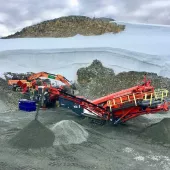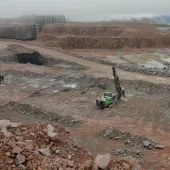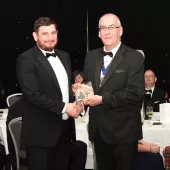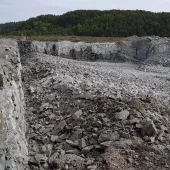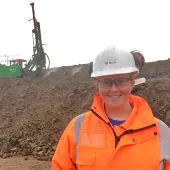BAM Ritchies celebrate 50 years
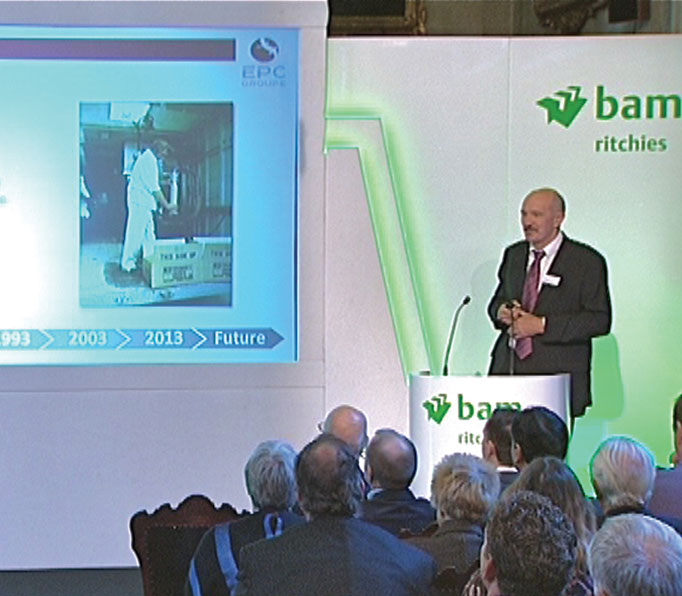
First published in the November 2013 issue of Quarry Management
Company marks anniversary with ‘Ground Engineering 50/50’ conference
On 18 September leading drilling, blasting and geotechnical service providers BAM Ritchies held a special one-day conference to celebrate their 50th anniversary at the Ironmongers’ Hall in the City Of London. The event was attended by 140 delegates from all sections of the geotechnical community and was themed as ‘Ground Engineering 50/50’, with speakers reflecting both on the evolution of the industry over the last 50 years and looking forward to developments in the next half century.
The conference was facilitated by Alasdair Henderson, general manager of BAM Ritchies, and seven well-known speakers made contributions to the programme on different aspects of geotechnics. Donald Lamont, director, Hyperbaric & Tunnel Safety Ltd, and former head of tunnel and ground engineering at the HSE, presented a review of safety legislation and practice in the sector over the last 50 years and drew attention to the need to manage longer-term health issues as well as the more immediate challenges of safety, such as the guarding of rotating parts.
Angela Yeoman gave a talk about how Foster Yeoman had been built up from small beginnings to become the largest family-owned quarrying business in Europe, producing some 11 million tonnes of aggregate per annum in better times. With characteristic directness, she pointed out that, with the market contraction in recent years, the number of quarries had reduced by 25% as the major groups had sought to concentrate production on a smaller number of larger units. This had resulted not only in the loss of local employment in rural areas, but also a loss of understanding of local needs. Also, she expressed her regret that there seemed to be too many specialists and not enough all-round quarrymen left in the industry.
With regard to the future, she questioned whether the deconsolidation of the aggregates industry had already started, as gaps left in the market were being filled by small local operators, specifically by producers of recycled aggregates, which now accounted for 20% of total production. In conclusion, while welcoming the trend back to localism, she had the grace to admit that she had been guilty of being closely involved with the move towards superquarries in the first instance!
Representing EPC UK, Rob Farnfield, head of explosives engineering, gave a review of the use of explosives in the UK extractive sector over the past 50 years, covering the changes in initiation systems and explaining how nitro-glycerine and ANFO had come to be replaced with packaged slurries and most recently by bulk emulsions. As to the future, he identified his ideal scenario as being a combination of ‘measure-by-drilling’ techniques, variable-energy explosives and the use of wireless detonators.
A soil mechanics perspective was given by Chris Clayton, professor in engineering and the environment at the University of Southampton, in a presentation entitled ‘Ground Investigation in the Eurocode Age’. It was explained that the science of soil mechanics was started around 50–60 years ago and the presentation showed how drilling, sampling and ground-investigation techniques had changed with significant improvements being made in areas such as health and safety and mobility, coupled with a move towards increasing standardization. With the ongoing growth of urban areas and limited availability of land in the UK, the reuse of building and construction sites was inevitable and contaminated land, archaeology and unexploded ordnance remained key issues in ground investigation.
Kenny Dempster, head of asset integrity with SEE (Scottish and Southern Energy), gave a client’s view of managing geotechnical assets. He started by explaining that SSE was the second largest power distribution company in the UK and was involved in power generation from a range of sources: coal, gas, hydro, wind and biomass. In concentrating on the infrastructure required for hydroelectric power in Scotland, in the form of dams, aqueducts, tunnels and pipelines, he gave examples of how water was collected from large catchment areas and moved over long distances to power station turbines. In a salutary example of the importance of geotechnical conditions, he explained how the collapse of a section of unlined tunnel at the £150 million Glendoe hydroelectric station in 2009 had prevented power being produced for two years while a diversion tunnel was created to bypass the affected area.
‘Trends in Ground Engineering’ was the title of a talk given by Rab Fernie, former technical director with Cementation Skanska and a former chairman of the British Geotechnical Association. In his opening remarks he explained that the UK had played a leading role in the development of the science and practice of ground engineering and British engineers were well respected around the world. Although most of the work in the early years had been generated by the creation of the motorway and road network, the majority of the current demand is now associated with inner-city contracts. He went on to question whether clients always understood the benefits of good site investigation and recommended the need to focus on whole-life costing. Looking to the future, he explained that technology was now available to allow sensors to be embedded in geotechnical structures, which allowed their condition to be monitored and interrogated to attain a measure of relative health.
The proceedings were concluded with a keynote address by Barry Clarke, president of the Institution of Civil Engineers and professor of civil engineering geotechnics at Leeds University. In a comprehensive presentation on the role of the engineer, an upbeat assessment of future infrastructure development was given that would require the number of engineers in the UK to be doubled by 2025. In promoting the cause of education he explained that students needed to be inspired to join the construction industry, businesses needed to innovate to survive and society needed to be better informed, in general, about the construction process. As to the future, he said that increasing expectations, decreasing resources and climate change all represented great challenges, and that he expected greater use to be made of underground space for a number of different purposes in the next 50 years.


